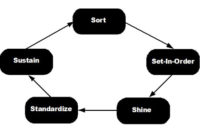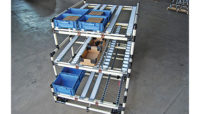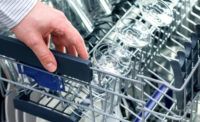A linchpin of any lean manufacturing effort, 5S programs help to reduce waste and optimize productivity through better workplace organization.
For the uninitiated, the five S’s stand for sort, set in order, shine, standardize, and sustain. The process can seem intimidating, but does not need to be. “You don’t have to get the 5S process perfect right away,” says Tina Huff, group product manager at Avery Products Corp., a commercial and industrial label manufacturer. “Just get started and keep improving over time.”
Industrial labels that are designed to be customized, applied and removed are ideal for organization and identification and can help to optimize each stage of the process.
Sort
The first 5S stage, sort, removes clutter and unneeded items from the work area. This leaves just the parts, tools, machines and supplies necessary for daily use on the shop floor or at the workstation. In this stage, temporary labels can be put on items as the plant’s staff sorts through them.
According to Huff, parts, tools and “stuff” can be labeled with the following: “leave,” “relocate,” “dispose or recycle,” or “TBD” (to be determined).
“Leave” is for items that can stay right where they are. “Relocate” is for any item that needs a new home because it is more logical or efficient. “Dispose or recycle” applies to unneeded items that can be discarded or recycled. “TBD” is for items that you are not sure of yet.
“One method is to mark items as TBD, and then wait a month or so,” says Huff. “When you use an item, consider how it’s used or who uses it to determine its permanent home. If you haven’t used it in that time, consider discarding it.”
For best results, be sure to use labels that are won’t fall off during the sort stage, yet don’t cause damage or leave behind residue when you need to remove them.
Set in Order
The second stage, set in order, locates parts, people, tools and equipment in the most efficient, ergonomic positions, so operators do not waste time or effort searching for needed items.
To improve workplace efficiency, identification labels can be used to identify and classify parts, tools and equipment, so items are easy to find and everything has a home. Racks, shelves and cabinets also make sense to label, as do smaller portable items like bins, totes and toolboxes, which help with organization.
Color coding labels can add another level of organization to items. With labels that are printed on a laser or ink-jet printer, it’s easy to include color, icons or even photos on labels. This makes it easier to quickly identify items and determine where they belong.
“For larger facilities, adding bar codes to labels can further improve efficiency because scanning a bar code is much faster and more accurate than manual entry,” says Huff. “This is vital for activities like inventory counts or pulling orders for shipment.”
Labels can be printed with either one- or two-dimensional bar codes. The latter hold far more data in less space. While 1D bar codes typically encode data such as location and department, 2D bar codes can also contain website addresses, images and even voice data.
Shine
The third stage, shine, ensures the workplace stays free of clutter, grime and malfunction. This helps to prevent serious work breakdowns or slowdowns. A clean workplace gives assemblers a sense of pride. Cleaning also serves as a de facto method of inspecting equipment for wear.
Equipment labels that are not durable can become torn or otherwise unreadable, which is a particular problem with bar code labels.
“During inspection, it’s good to replace any damaged or inaccurate labels,” says Huff.
Also, keep track of machine maintenance with inspection labels so routine maintenance isn’t forgotten. This helps to prevent costly downtime and improve safety by reducing malfunction-related accidents. Make sure there is a process in place so whoever is responsible knows which machines they need to inspect, and how often. A good inspection label will include areas for marking the date and person who conducted the inspection.
It’s important to use identification labels that are designed to withstand daily wear and tear, dirt, grease, oil, chemicals and wash downs while providing good bar code readability.
Standardize
The fourth stage, standardize, systematizes the most efficient work methods with clear standards. Schedules, checklists and standard
operating procedures are a key part of this process.
Without standard operating procedures and clear processes, an assembly plant will not run consistently and smoothly, even if everything is labeled accurately. Wherever possible, it is helpful to put procedures and checklists on labels posted near work areas.
“Placing labels on work area equipment provides employees with a recurrent reminder of standard operating procedures, so no one can say ‘I didn’t know,’” says Huff. This is especially critical for reminders or instructions, since labels are less likely than sheets of paper to get lost or damaged.
Sustain
The fifth stage, sustain, is about teaching and maintaining company standards and procedures until they become a habit and are consistently followed. Because 5S is a continuous process, however, organizations will reorganize or improve processes throughout the year, as well as accommodate changes in data, format and regulation.
To facilitate that process, it should be easy to remove old labels and print custom, updated ones. Otherwise, employees can waste time scraping old labels off, using heat guns or even razor blades. They may be reluctant to update labels if it is difficult to get the old ones off, so may make do with substandard situations.
The ideal solution would be to use industrial labels for organization and identification that are easy to adhere, durable enough to endure harsh conditions, yet come off cleanly when necessary, leaving no trace.
“Industrial labels used for signage and identification must be more durable than those used in an office, but they should remove cleanly when they need to come down,” says Huff. “The key to accomplishing this was developing an adhesive that holds well but can be removed when needed. Achieving that balance is harder than it sounds.”
For example, Avery’s new Surface-Safe sign labels and ID labels have an exclusive, proprietary construction specially engineered to stick securely yet remove cleanly without damage or residue from a wide variety of industrial surfaces. Surface-Safe sign labels can be used on walls, doors and glass, without worrying about damaging the surface. The Surface-Safe ID labels are designed to be used on plastic and metal surfaces, so are readily usable on machinery, racks, shelves, cabinets, totes and bins, even if the surface is highly textured.
These “labels used as signs or identification” are made of durable, industrial-grade material that resists water, chemicals and even abrasion. Unlike office labels with a paper substrate, the topcoat of the industrial labels is waterproof and chemical resistant. The labels’ polyester substrate is a durable, scuff- and tear-resistant film.
Available in a variety of sizes, they print easily on standard laser or ink-jet printers, enabling custom, do-it-yourself labels for signs and identification. The company’s free online Design and Print Software allows customizable printing utilizing OSHA- and ANSI-compliant templates and 5S templates.
Employees can create and print their own informal, official or compliant labels from predesigned templates or create them step-by-step at their desk. Employees find the process intuitive, since it resembles creating an office document from predesigned templates.
To accommodate warehouse settings, the software’s bar code generator makes it easy to add text, graphics, serialized numbers or bar codes in a few steps. The combination of a bright white label material with superior ink or toner adhesion further enables accurate bar code scanning, even at extended distances.
With all the equipment, supplies, racks and other gear used in industrial settings, the ability to conveniently print new 5S sign and identification labels in minutes, while being able to cleanly remove the old ones, will go a long way toward keeping facilities efficiently up to date without the hassle, mess or cost.
For more information visit www.avery.com/industrial.







